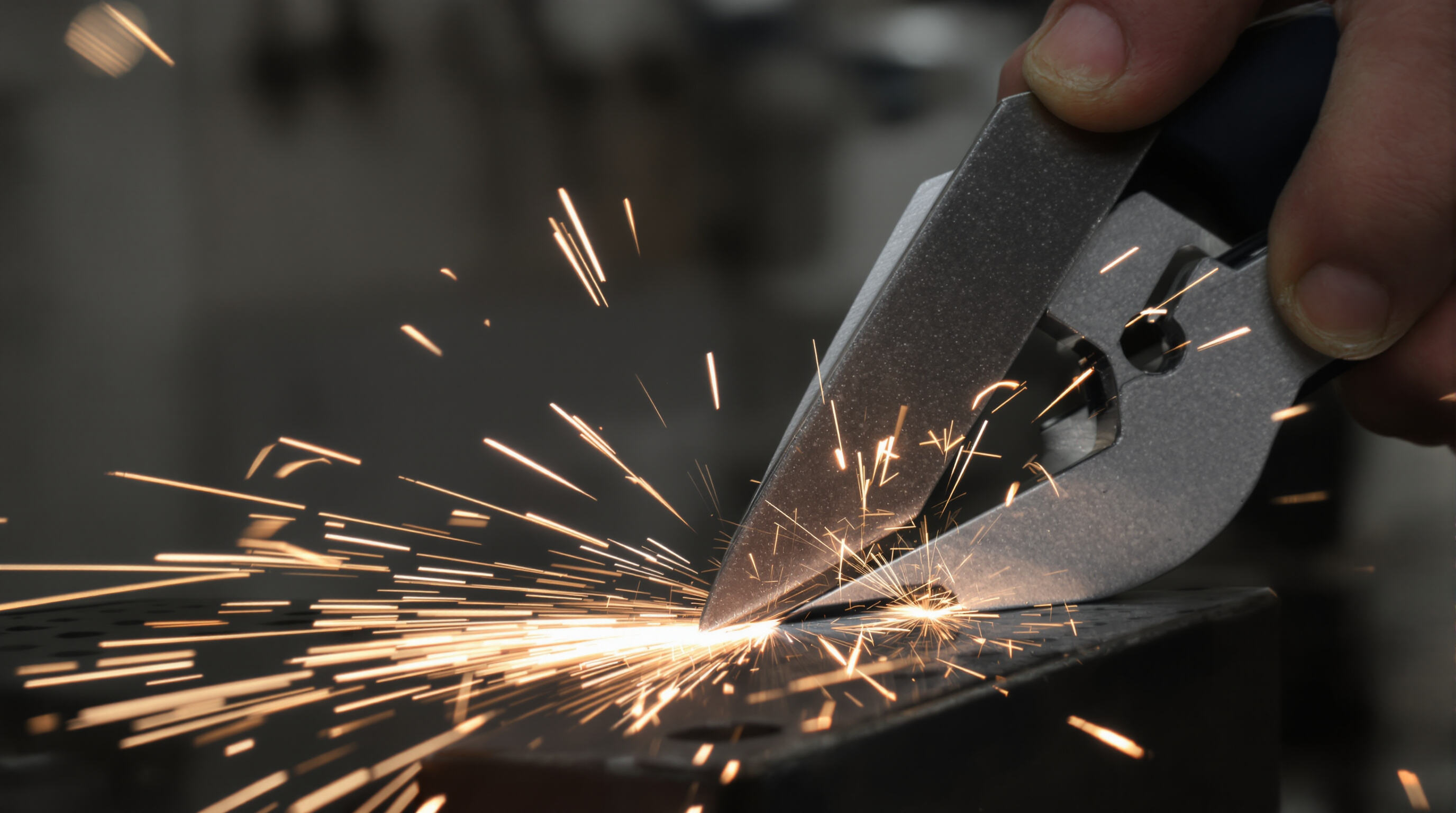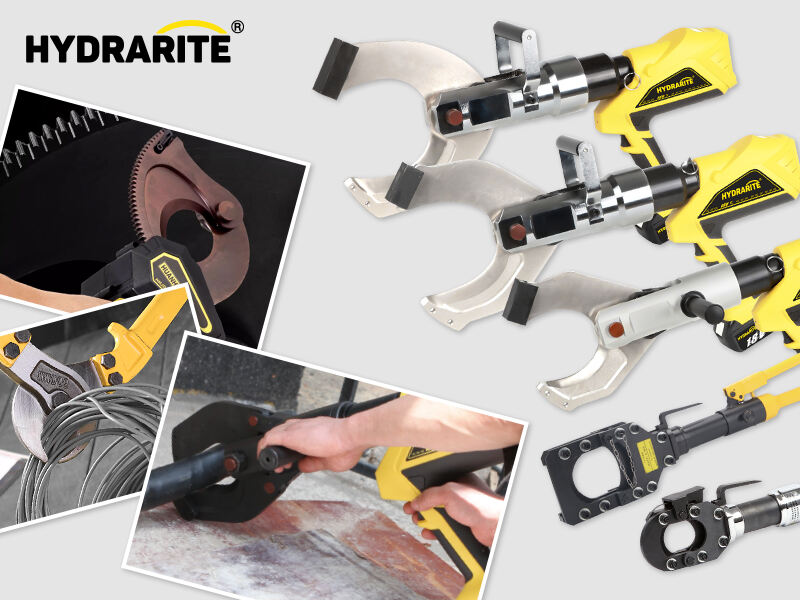Initial Inspection and Regular Cleaning of Cable Cutters
Conducting a thorough initial inspection upon acquisition or after heavy use
It's important to check cable cutters for any obvious problems either before using them for the first time or after some serious work has been done. Look closely at the blades to see if there are chips, cracks, or if they don't line up properly. Also make sure the handles open and close freely without getting stuck somewhere along the way. According to a survey conducted by Federal Equipment Maintenance last year, around one in four tool failures actually comes down to small issues that weren't spotted during manufacturing or got damaged while being shipped. Don't forget to test how tight the springs are and measure the space between the blades when closed. If this gap gets bigger than half a millimeter, the cutter just won't work as well anymore and probably needs attention soon.
Clean the cutter regularly to remove dirt, grease, and debris
Leftover bits of metal from copper or aluminum wiring tend to speed up blade corrosion over time. A quick wipe with a dry microfiber after every session works wonders, especially around those tricky spots where blades meet their grooves and pivot points. When dealing with really stubborn gunk, reach for a soft nylon brush instead of anything harsh that might scratch the special coatings on steel parts. Don't forget to give tools a thorough going over every two weeks too. Regular maintenance keeps abrasive stuff from building up between blades something research indicates actually makes blade gaps grow wider by about 18 percent each year according to findings published in Tool Maintenance Quarterly back in 2023.
Using appropriate tools and solvents for effective cleaning without damaging components
Avoid petroleum-based cleaners that degrade rubberized handles and epoxy coatings. Instead, use a 70% isopropyl alcohol solution applied with cotton swabs to dissolve grease safely. After cleaning carbon steel blades, apply a rust-inhibiting spray to protect against moisture exposure.
Establishing a cleaning routine to support long-term cable cutter performance
Implement a tiered maintenance schedule:
- Daily: Wipe blades with a dry cloth
- Weekly: Brush pivot points to remove accumulated dust
- Monthly: Disassemble and clean with solvent if permitted by manufacturer guidelines
This structured approach reduces wear by 41% compared to reactive cleaning (Industrial Tooling Report, 2023). Store cleaned tools in a silica-gel-lined case to maintain a dry environment between uses.
Proper Lubrication to Ensure Smooth Operation and Prevent Rust
Lubricate moving parts to ensure smooth operation and prevent rust
When it comes to keeping tools running smoothly, lubricating those pivot points and moving joints really makes a difference. Friction gets reduced, which means less wear and tear overall. Some industry research suggests tool life can actually last about 30% longer with proper lubrication. Pay special attention to spots where parts rub together most often, like that spring loaded handle mechanism or where the blade rotates around its axis. Before slapping on any oil or grease though, make sure to clean away all the built up dirt first. Otherwise, those tiny bits of grit will just get mixed right into the lubricant and end up scratching up important parts over time.
Selecting the right lubricant for cable cutters based on material and usage frequency
Stainless steel models benefit from silicone-based sprays that resist washout in wet or outdoor conditions, while carbon steel cutters require heavier corrosion-inhibiting oils. High-use environments demand synthetic lubricants rated for 10,000+ operation cycles, as outlined in equipment maintenance guidelines. Avoid WD-40 for long-term protection due to its fast evaporation rate.
Applying oil strategically to pivot points and blade edges for maximum efficiency
Use a precision dropper to apply lubricant directly to three key zones:
- Blade hinge screws (primary friction point)
- Spring coils (to prevent compression fatigue)
- Base of the cutting edge (to guard against micro-fractures)
Operate the cutter 8–10 times after application to evenly distribute the lubricant across bearing surfaces. Finish by wiping away excess with a lint-free cloth to minimize dust attraction.
Avoiding the pitfalls of over-lubrication and under-lubrication in cable cutter maintenance
According to some tool failure stats from 2023, around 62 percent of problems related to lubrication actually come down to using the wrong amount of oil. When there's not enough lubricant, tools become harder to handle and the blades start showing signs of scoring. On the flip side, too much oil creates another problem entirely since it pulls in metal shavings which then scratch surfaces as they move around. For checking if everything's right, try doing this simple test once a month. Just grab some clean paper and work the cutter open and closed over it. Good lubrication should leave behind only light marks without any actual dripping or completely dry areas showing through.
Sharpening and Blade Maintenance for Optimal Cutting Performance

Identifying signs of dullness in cable cutter blades during routine use
Dull blades develop burrs, uneven edges, or require excessive force to cut. According to a 2023 National Institute for Occupational Safety study, operators experience a 40% increase in hand strain when using worn blades on steel cables. Incomplete cuts or frayed wire ends are clear indicators that sharpening is needed immediately.
Sharpening cutting edges with precision tools while maintaining original blade angle
Restore blade sharpness using diamond-coated files or ceramic stones at the manufacturer’s specified angle—typically 25–30 degrees. Maintaining the correct angle improves blade longevity by 70%, per the 2024 Industrial Cutting Tools Report. For copper cables, a finer 22–25° edge preserves material integrity and prevents deformation.
Comparative analysis: DIY sharpening vs. professional blade servicing
| Factor | DIY Sharpening | Professional Servicing |
|---|---|---|
| Cost Per Session | $8–$15 (abrasives) | $45–$85 (service fee) |
| Precision Tolerance | ±3° (average) | ±0.5° (laser-guided systems) |
| Time Investment | 45–60 minutes | 24–48 hr turnaround |
Data from 2023 machine tool maintenance records indicate that 35% of DIY sharpening attempts result in irreversible coating damage.
Recommended sharpening frequency based on cable types (e.g., copper, steel)
- Copper: Sharpen every 1,500 cuts (softer metal causes gradual edge rounding)
- Steel: Sharpen every 500 cuts (harder material leads to faster wear)
Research from the Institute of Electrical Maintenance (2024) shows aluminum-jacketed cables require sharpening 30% less frequently than solid metal cores.
Preventative Maintenance and Routine Inspections to Extend Lifespan
Follow a regular maintenance schedule including cleaning, lubrication, and blade care
Commercial-grade cable cutters last up to 40% longer when maintained biweekly. Integrate blade inspections with post-use cleaning and lubrication to streamline upkeep. Dedicate 10–15 minutes monthly for full disassembly and debris removal where allowed, ensuring optimal function across all operational phases.
Check and adjust tension settings for optimal cutting efficiency
Incorrect tension can reduce cutting force by up to 25%, per 2023 engineering tests. Test adjustments using medium-gauge steel cables—ideal tension allows clean, single-stroke cuts without excessive hand pressure. Follow manufacturer instructions and adjust spring-loaded components in ¼-turn increments until consistent performance is achieved.
Inspect the cutter blades for wear, damage, and alignment
Use a magnifying glass to detect micro-fractures along cutting edges that impair precision. Rotational misalignment, evident through uneven contact during test cuts, contributes to 30% of early tool failures. Track blade thickness monthly and replace if wear exceeds 0.5mm to preserve cutting capacity across materials.
Promptly addressing minor issues before they lead to major tool failure
Tightening a loose pivot bolt immediately can prevent thread damage that might otherwise cost $80–$120 to repair. This proactive mindset extends service life by 2–3 years, based on data from industrial maintenance programs.
Safe Storage and Corrosion Prevention for Long-Term Tool Integrity
Store the Cable Cutter in a Dry, Well-Ventilated Place Away From Moisture and Heat
Humid environments accelerate corrosion by 40% in untreated tools (Material Durability Journal 2023). Store cable cutters in areas with relative humidity below 50%, ideally at temperatures between 15–25°C. Avoid damp locations like concrete floors, outdoor sheds, or near boilers, all of which promote moisture retention and rust development.
Using Protective Cases or Wall-Mounted Racks for Organized and Safe Storage
Toolboxes with closed-cell foam inserts protect blades from nicks during transport, while wall-mounted racks with rubberized hooks reduce stress on handles. Keep cutters separate from impact tools like hammers or grinders to prevent accidental blade chipping. A 2023 tool longevity survey found organized storage extends cutter lifespan by 63%.
Rust Prevention and Treatment: Applying Anti-Corrosive Coatings Post-Use
Once everything is clean, go ahead and wipe down those blades using a good quality lint free cloth. Apply a light coating of VpCI spray afterward to keep things protected from corrosion. When dealing with tools that get constant action, don't forget to put some paste type protectant right onto those pivot points where wear tends to happen fastest. The frequency really depends on how much they're being used, but generally speaking, most folks find that topping up every couple of months works well, especially if storing away for long periods. Spotting some surface rust? No big deal at first glance, but ignore it too long and it becomes a bigger headache. Grab a cloth soaked in white vinegar and give that area a good rub down, followed by fresh oil application as soon as possible to rebuild the protective barrier against future damage.
FAQ
Why is regular cleaning of cable cutters important?
Regular cleaning helps remove dirt, grease, and debris that can lead to corrosion and wear over time, preserving the tool's functionality and longevity.
What type of lubricant should I use for cable cutters?
Select a lubricant based on the material and usage. Silicone-based sprays are suitable for stainless steel, while heavier corrosion-inhibiting oils are best for carbon steel. Avoid WD-40 for long-term protection.
How can I tell if my cable cutter blades are dull?
Dull blades typically show burrs, uneven edges, or require excessive force to cut. They may also leave incomplete cuts or frayed wire ends.
What are the recommended storage conditions for cable cutters?
Store cable cutters in a dry, well-ventilated place away from moisture and heat, ideally with relative humidity below 50% and temperatures between 15–25°C.
Table of Contents
-
Initial Inspection and Regular Cleaning of Cable Cutters
- Conducting a thorough initial inspection upon acquisition or after heavy use
- Clean the cutter regularly to remove dirt, grease, and debris
- Using appropriate tools and solvents for effective cleaning without damaging components
- Establishing a cleaning routine to support long-term cable cutter performance
-
Proper Lubrication to Ensure Smooth Operation and Prevent Rust
- Lubricate moving parts to ensure smooth operation and prevent rust
- Selecting the right lubricant for cable cutters based on material and usage frequency
- Applying oil strategically to pivot points and blade edges for maximum efficiency
- Avoiding the pitfalls of over-lubrication and under-lubrication in cable cutter maintenance
-
Sharpening and Blade Maintenance for Optimal Cutting Performance
- Identifying signs of dullness in cable cutter blades during routine use
- Sharpening cutting edges with precision tools while maintaining original blade angle
- Comparative analysis: DIY sharpening vs. professional blade servicing
- Recommended sharpening frequency based on cable types (e.g., copper, steel)
- Preventative Maintenance and Routine Inspections to Extend Lifespan
- Safe Storage and Corrosion Prevention for Long-Term Tool Integrity
- FAQ


